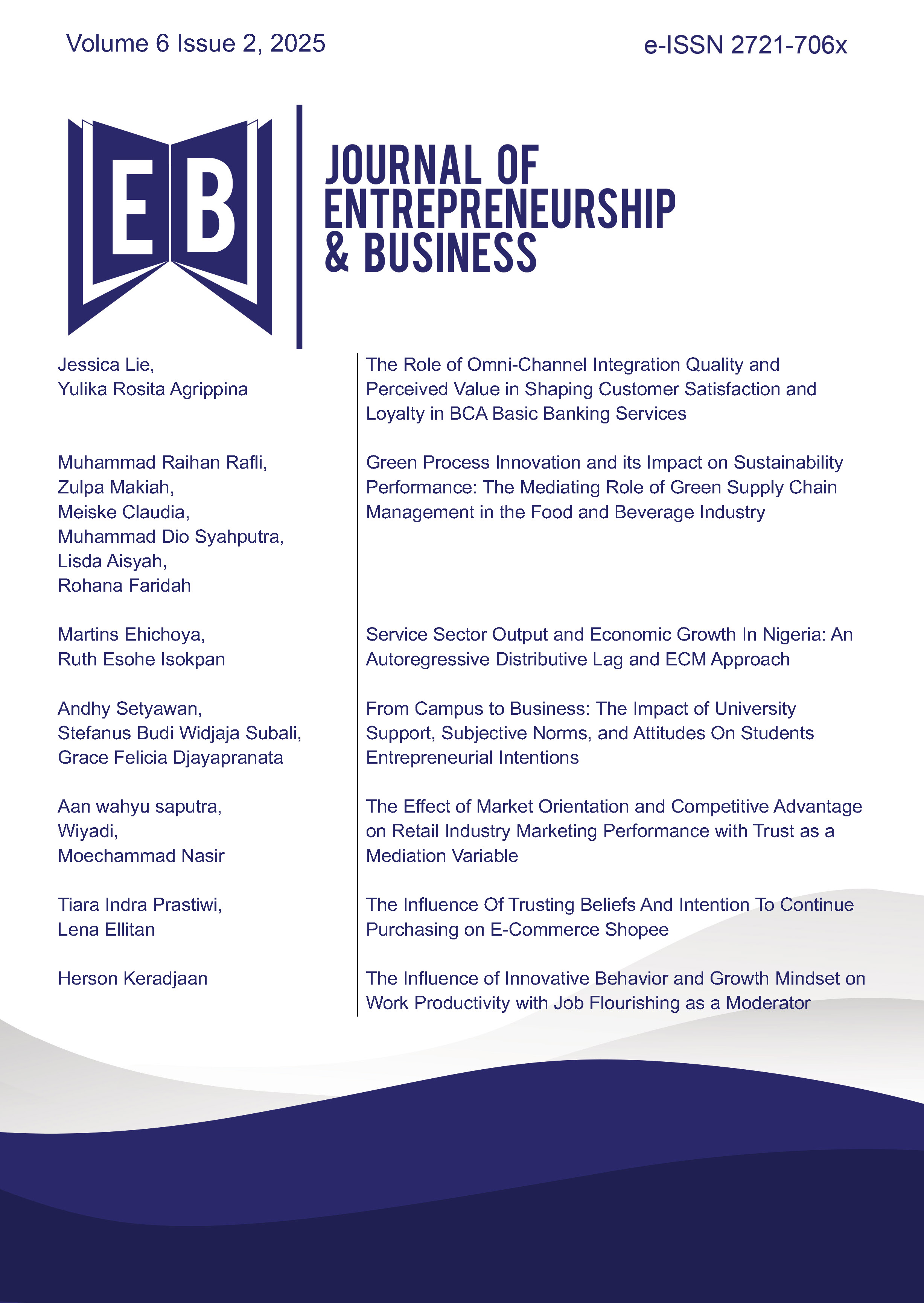Service Sector Output and Economic Growth In Nigeria: An Autoregressive Distributive Lag and ECM Approach
 Abstract Views:
351 times
Abstract Views:
351 times
 PDF Downloads:
111 times
PDF Downloads:
111 times
Abstract
Purpose: Recent technological advancements in manufacturing have diminished employment opportunities for low-skilled workers, particularly in developing economies, resulting in slower job creation and productivity growth. In light of this challenge, many nations are seeking alternative pathways to stimulate economic expansion. This study examines the potential of Nigeria's service sector as a driver of growth, focusing on the impact of key sub-sectors, Education (EDU), Real Estate (RES), Health Services (HES), and Trade (TRD) alongside government regulation (proxied by inflation).
Method: The study uses Central Bank of Nigeria data (1981–2023) and applies econometric techniques, including the Augmented Dickey-Fuller (ADF) test, Johansen Cointegration test, and Error Correction Mechanism (ECM). These assess stationarity, long-run equilibrium, and short-term dynamics. The ADF test confirms stationarity after first differencing, while cointegration reveals five long-term equilibrium relationships.
Result: HES significantly boost short-term economic growth, while TRD has a positive but insignificant effect. RES negatively impacts growth, whereas EDU shows an insignificant negative link. To improve performance, the study recommends increased healthcare investment, sustained public administration expansion, and financial reforms to strengthen the service sector, mitigating adverse effects and promoting sustainable growth.
Downloads
References
Adeleye, O., & Shittu, M. (2018). Inflation, manufacturing output and economic growth: Nigeria experience. The Social and Management Scientist, 10(1), 43-47. https://doi.org/10.55493/5009.v10i2.4521
Adofu, I., Taiga, U. & Tijani, Y. (2015). Manufacturing sector and economic growth in Nigeria. Donnish Journal of Economics and International Finance, 1(1), 1-6.
Afolabi, A., & Laseinde, O. (2019). Manufacturing sector performance and economic growth in Nigeria. Journal of Physics. https://doi.org/10.1088/1742-6596/1378/3/032067
Awake, (2002). Globalization: course or cure. Journal Awake, 22, 1-14.
Babatunde, A., & Adefabi, A., (2005). Long-Run relationship between education and economic growth in Nigeria: evidence from johannes’ cointegration approach. Regional conference on education in West Africa: constraints and opportunities..
Barro, R. J. (1990). Government Spending in a Simple Model of Endogenous Growth. Journal of Political Economy, 98 (5), 103-S125. https://doi.org/10.1086/261726
Barro, R., & Sala-i-Martin, X. (1992). Public finance in models of economic growth. The Review of Economic Studies, 59 (4), 645-661. https://doi.org/10.2307/2297991
Barro, R. J. (1999). Determinants of Economic Growth: Implications of the Global Evidence for Chile. Cuadernos de Economía, 36 (107), 443-478.
Barro, R. J. (2003). Determinants of economic growth in a panel of countries. Annals of Economics and Finance, 4, 231-274.
Bell, D. (1973). The coming of the post-industrial society: a venture in social forecasting. Middlesex: Penguin Books.
Burnside, C., & Dollar, D. (2000). Aid, policies, and growth. The American Economic Review, 90(4), 847-868. https://doi.org/10.1257/aer.90.4.847
Business News (2014). Services sector drives 6.21% growth in GDP – NBS. 17th July, Available online: https://businessnews.com.ng/2014/07/17/services-sector-drives-6-21-growth-gdp-nbs/
Chandra, A. (2011). Nexus between Government Expenditure on Education and Economic Growth: Empirical Evidences from India.
Chirwa, T. &. Odhiambo, N. (2016). Macroeconomic determinants of economic growth: a review of international literature. South East European Journal of Economics and Business 11(2), 33-47. https://doi.org/10.1515/jeb-2016-0009
Chukwuedo, O. S., & Ifere, E. O. (2017). Manufacturing subsector and economic growth in Nigeria. British Journal of Economics, Management and Trade, 17(3), 1-9. https://doi.org/10.9734/BJEMT/2017/29352
Clark, C. (1940). The conditions of economic progress. McMillan & Co, London.
David, V. (2007). Barrier or benefits? Regulation transatlantic Trade. Washington, D.C Brooking Institute Press.
Dicken, P. (2003). Global shift: transforming the world economy. London: Paul Chapman
Dogara E. J. (2018). The Impact of Manufacturing on Economic Growth in Nigeria: an autoregressive distributed lag model approach. International Journal of Economics and Management Studies, 5(8), 14-20. https://doi.org/10.14445/23939125/IJEMS-V5I8P103
Dorian, S.K. (1997). Education and health in an effective-labour empirical growth model. The Economic Record, 73, 314-328. https://doi.org/10.1111/j.1475-4932.1997.tb01026.x
Easterly, W. & Levine, R., (1997). Africa’s growth tragedy: Policies and ethnic divisions. Quarterly Journal of Economics, 122(4), 1203–1250. https://doi.org/10.1162/003355300555466
Farhadi, M., Ismail R., & Fooladi, M. (2012). Information and communication technology use and economic growth. PLoS ONE, 7(11). https://doi.org/10.1371/journal.pone.0048903
Fidelis, O. & Olukayode, E. (2012). Globalization and economic growth in Nigeria: a multidimensional analysis. Pakistan Journal of Social Sciences, 9(2), 89-95. https://doi.org/10.3923/pjssci.2012.89.95
Fisher, A. (1935). Clash of progress and security. Macmillan and Co. Limited, London.
Fourasti´e, J. and Siegfried, A. (1949). The great hope of the 20th century: technical progress, economic progress, social progress. Presses Universitaires de France, Paris.
Garry, B. (2013). Globalization confronting fear about open trade. Washington, D.C Brooking Institute Press.
Grossman, G. & Helpman, E. (1991). Innovation and growth in the global economy. MIT Press.
Haksever, C., & Render, B. (2013). Service management: an integrated approach to supply chain management and operations. Upper Saddle River, NJ: FT Press.
Idowu, D. (2014). The impact of health on economic growth in Nigeria. Journal of Economics and Sustainable Development, 5(19).
Iwuagwu, O. (2014). Telecommunications Reform in China and Nigeria: same result, different strategies. Journal of International Social Research, 7(32), 652- 668.
Isikhuemen, A., Aigheyisi, O., & Iseghohi, J. (2019). Comparative analysis of the long run effects of economic, political and social-cultural globalization on Nigeria's economic growth. Nigerian Journal of Management Sciences, 7(1), 168-174.
Kuznets, S. (1966). Modern economic growth: rate, structure and spread, new haven, CT. Yale University Press.
Kuznets, S. (1957). Quantitative aspects of the economic growth of nations: II. Industrial distribution of national product and labor force. Economic development and cultural change, 5(4). https://doi.org/10.1086/449740
Lucas, R., (1988). On the mechanics of economic development. Journal of Monetary Economics 22(1), 3–42. 10.1016/0304-3932(88)90168-7
Mail and Guardian (2014). Oil, gas play second fiddle to Nigeria’s services sector. 7th April. Available online: https://mg.co.za/article/2014-04-07-oil-gas-play-second-fiddle-to-nigerias-services-sector/
Mazeli, N., Ejinkonye, C., Uloghobui, M., & Onehi, H. (2024). Effect of manufacturing sector output on economic growth in Nigeria: 1981-2022. African Banking and Finance Review Journal, 11(11), 16-26.
Musila, J., & Belassi, W. (2004). The impact of education expenditures on economic growth in Uganda. https://doi.org/10.1016/j.econmod.2003.10.009.
Nwogwugwu, U. C., Metu, A. G., & Ihugba, O. A. (2021). Do disaggregated manufacturing sectors matter in Nigerias economic growth: VECM approach? Journal of Economics and International Finance, 13(2), 85-99. https://doi.org/10.5897/JEIF2021.1133
Obioma, K., Anyawu, N., & Kalu, A. (2015). The Effect of Industrial Development on Economic Growth Empirical Evidence in Nigeria. European Journal of Business and Social Sciences, 4(2), 127-140. http://doi.org/10.13140/RG.2.2.28272.97289
Ogundipe, M. (2022). The impact of manufacturing sector on economic growth in Nigeria. https://doi.org/10.21203/rs.3.r-2203096/v1.
Olusoji, M. & Odeleye, A. (2018). Service sector potentials in the transformation of the Nigerian economy. BizEcons Quarterly, 2, 24-35.
Omotor, D., Orubu, C., & Inoni, E. (2009). Policy Reforms and Agricultural Exports in Nigeria: An Empirical Analysis. Singapore Economic Review, 54(4), 589-603. https://doi.org/10.1142/S0217590809003501
Owan, P., Garbini, J. & Devasia, S. (2020) Faster confined space manufacturing teleoperation through dynamic autonomy with task dynamics imitation learning. IEEE Robotics and Automation Letters, 5(2), 2357-2364. http://doi.org/10.1109/LRA.2020.2970653
Owoeye, A. (2005). Human capital and economic development: an empirical analysis of a developing economy. Univerity of Ado-Ekiti, Nigeria. http://doi.org/10.2139/ssrn.726748
Paul, R. (2012). Information technology: Panacea or peril. UNU Work in Progress, 15(1).
Pegkas, P., & Tsamadias, C. (2014). Does Higher Education Affect Economic Growth? The Case of Greece. https://doi.org/10.1080/10168737.2014.894551
Peter, S. Rita, E. & Makwe, E. (2015). The Impact of road transportation infrastructure on economic growth in Nigeria. International Journal of Management and Commerce Innovations, 3(1), (673-680).
Pilat, D., & Anita, W. (2005). Measuring the Interactions between Manufacturing and Services. STI Working paper 2005/5. Paris: OECD. https://doi.org/10.2139/ssrn.1690954
Rodríguez M., & Melikhova Y. (2015) Services in Russia: past, present, and future. Eurasian Geography and Economics, 56 (6), 656-678. https://doi.org/10.1080/15387216.2015.1178336
Radelet, S., Sachs, J. & Whang-Lee, J. (2001). The Determinants and prospects of economic growth in Asia. International Economic Journal, 15(3), 1-29. https://doi.org/10.1080/10168730100000041
Romer, P. M., (1986). Increasing returns and long-run growth. Journal of Political Economy 94(5), 1002–1036. https://doi.org/10.1086/261420
Schuurman, F. (2011). Globalization and development studies: challenges for the 21st century, London, Sage.
Sachs, J. D., & Warner, A. M. (1997). Fundamental sources of long-run growth. The American Economic Review, 87, (2), 184-188.
Solow, R. M. (1957). A contribution to the theory of economic growth. The Quarterly Journal of Economics,70(1), 65-94. https://doi.org/10.2307/1884513
Solow, R., (1956). A contribution to the theory of economic growth. Quarterly Journal of Economics, 65-94. https://doi.org/10.2307/1884513
Thorn, W. (2014), Oil, gas play second fiddle to Nigeria's services sector, mail & guardian.
Timmer, P., de Vries, J., & de Vries, K. (2015). Patterns of Structural Change in Developing Countries. In J. Weiss, & M. Tribe (Eds.). Routledge Handbook of Industry and Development. 65-83. https://doi.org/10.4324/9780203387061-4
Todaro, M. & Smith, M. (2011). Economic Development, London: Addison-Wesley

This work is licensed under a Creative Commons Attribution 4.0 International License.
Articles published in Journal of Entrepreneurship & Business are licensed under a Creative Commons Attribution 4.0 International (CC BY) license. You are free to copy, transform, or redistribute articles for any lawful purpose in any medium, provided you give appropriate credit to the original author(s) and the journal, link to the license, and indicate if changes were made.
Authors submitting to this journal agree to make their work freely available under the CC BY 4.0 license, ensuring broad dissemination and reuse. The full license details can be accessed at https://creativecommons.org/licenses/by/4.0/.
This ensures that they receive the maximum dissemination because there are no barriers to access. This license allows readers to disseminate and reuse the paper, but always requires them to grant the authors and the first publication full credit.
While JEB upholds ethical publishing standards, the responsibility for ensuring originality and compliance with copyright regulations lies with the authors. The journal is not liable for any legal claims related to the content of published articles.
For further inquiries, please contact the editorial team.

 DOI:
DOI:











